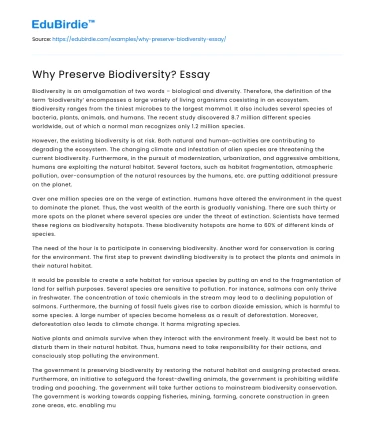Biodiversity is an amalgamation of two words – biological and diversity. Therefore, the definition of the term ‘biodiversity’ encompasses a large variety of living organisms coexisting in an ecosystem. Biodiversity ranges from the tiniest microbes to the largest mammal. It also includes several species of bacteria, plants, animals, and humans. The recent study discovered 8.7 million different species worldwide, out of which a normal man recognizes only 1.2 million species.
However, the existing biodiversity is at risk. Both natural and human-activities are contributing to degrading the ecosystem. The changing climate and infestation of alien species are threatening the current biodiversity. Furthermore, in the pursuit of modernization, urbanization, and aggressive ambitions, humans are exploiting the natural habitat. Several factors, such as habitat fragmentation, atmospheric pollution, over-consumption of the natural resources by the humans, etc. are putting additional pressure on the planet.
Save your time!
We can take care of your essay
- Proper editing and formatting
- Free revision, title page, and bibliography
- Flexible prices and money-back guarantee
Over one million species are on the verge of extinction. Humans have altered the environment in the quest to dominate the planet. Thus, the vast wealth of the earth is gradually vanishing. There are such thirty or more spots on the planet where several species are under the threat of extinction. Scientists have termed these regions as biodiversity hotspots. These biodiversity hotspots are home to 60% of different kinds of species.
The need of the hour is to participate in conserving biodiversity. Another word for conservation is caring for the environment. The first step to prevent dwindling biodiversity is to protect the plants and animals in their natural habitat.
It would be possible to create a safe habitat for various species by putting an end to the fragmentation of land for selfish purposes. Several species are sensitive to pollution. For instance, salmons can only thrive in freshwater. The concentration of toxic chemicals in the stream may lead to a declining population of salmons. Furthermore, the burning of fossil fuels gives rise to carbon dioxide emission, which is harmful to some species. A large number of species become homeless as a result of deforestation. Moreover, deforestation also leads to climate change. It harms migrating species.
Native plants and animals survive when they interact with the environment freely. It would be best not to disturb them in their natural habitat. Thus, humans need to take responsibility for their actions, and consciously stop polluting the environment.
The government is preserving biodiversity by restoring the natural habitat and assigning protected areas. Furthermore, an initiative to safeguard the forest-dwelling animals, the government is prohibiting wildlife trading and poaching. The government will take further actions to mainstream biodiversity conservation. The government is working towards capping fisheries, mining, farming, concrete construction in green zone areas, etc. enabling multiple species to interact and interconnect freely.






 Stuck on your essay?
Stuck on your essay?

